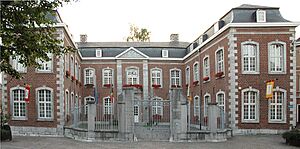German-speaking Community of Belgium facts for kids
The German-speaking Community of Belgium (called Deutschsprachige Gemeinschaft Belgiens in German, or DGB for short) is one of the three main parts of Belgium. It's mostly found in an area known as the East Cantons (Ost-Kantone in German).
This community covers about 854 square kilometers (330 square miles). More than 73,000 people live here, and almost all of them speak German.
The capital city is Eupen. This area is part of the Liège province and shares borders with the Netherlands, Germany, and Luxembourg.
A Bit of History
The area now known as the East Cantons used to be part of Germany until 1920. After Germany lost World War I, this land became part of Belgium because of the Treaty of Versailles. People sometimes called them the "redeemed cantons."
The peace treaty said that the local people should be asked if they wanted to be Belgian. However, this wasn't a secret vote. Anyone who didn't want to become Belgian had to write down their full name and address. Many people were scared of what might happen to them if they said no, like being punished or even forced to leave.
In the mid-1920s, Belgium even thought about selling the region back to Germany, but the French government stopped these talks.
Then, in 1940, during World War II, Germany took the cantons back. They had only been part of Belgium for 20 years, so many people still felt German. After Germany lost the war in 1945, the cantons became part of Belgium again.
In the early 1960s, Belgium was divided into four language areas: the Dutch-speaking area, the French-speaking area, the capital city of Brussels (where both languages are spoken), and the German-speaking area. In 1973, Belgium created three "communities" and three "regions." These groups were given some power to govern themselves. The German-speaking Community got its own parliament, called the Rat der Deutschsprachigen Gemeinschaft.
Today, the German-speaking Community has a good amount of self-government, especially for things like language and culture. However, it is still part of the French-speaking region called Wallonia. Some people, like the current Minister-President Karl-Heinz Lambertz, would like the German-speaking Community to become its own separate region.
How the Government Works
The German-speaking Community has its own government. This government is chosen every five years by its parliament.
The leader of the government is called the Minister-President. You can think of them as the "prime minister" for the Community. They are helped by the Ministry of the German-speaking Community.
Currently, the government has four ministers:
- Karl-Heinz Lambertz: He is the Minister-President and also in charge of local authorities.
- Bernd Gentges: He is the Deputy Minister-President and handles job training, employment, social issues, and tourism.
- Oliver Paasch: He is the Minister for Education and Research.
- Isabelle Weykmans: She is the Minister for Culture, Media, historical sites, youth, and sports.
Towns and Cities
Here are the towns that are part of the German-speaking Community:
Images for kids
-
The Executive (government) of the German-speaking Community meets in Eupen.
See also
 In Spanish: Comunidad Germanófona de Bélgica para niños
In Spanish: Comunidad Germanófona de Bélgica para niños








